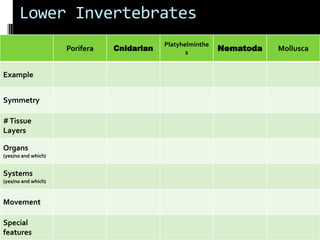Invertebrate review chart
•Download as PPTX, PDF•
1 like•2,018 views
The document discusses lower invertebrates and provides review questions about their characteristics and complexity. It asks questions about the simplest and most complex invertebrate phyla, types of symmetry, and parts of the crayfish. Review questions cover characteristics of flatworms and roundworms, differences in complexity between sponges and mollusks, common characteristics among listed groups, and types of symmetry. The document then shifts to discussing higher invertebrates and provides additional review questions comparing them to lower invertebrates.
Report
Share
Report
Share

Recommended
More Related Content
Similar to Invertebrate review chart
Similar to Invertebrate review chart (20)
Biol 11 Lesson 1 Feb 1 - Ch 26 Introduction to the Animal Kingdom

Biol 11 Lesson 1 Feb 1 - Ch 26 Introduction to the Animal Kingdom
Questions about Nematoda 1- What is ecdysis- 2- How does movemen in a.docx

Questions about Nematoda 1- What is ecdysis- 2- How does movemen in a.docx
the conclusion in secoand picture - Are you comfortable with the concl.docx

the conclusion in secoand picture - Are you comfortable with the concl.docx
Lesson Plan and Worksheets on Characteristics of Living Lhings

Lesson Plan and Worksheets on Characteristics of Living Lhings
classifying animals & phylum arthropods / classifying plants /dichotomous keys

classifying animals & phylum arthropods / classifying plants /dichotomous keys
Mendel's laws of heredity part 3 (pp.258-259)-answer key

Mendel's laws of heredity part 3 (pp.258-259)-answer key
Vertebrates and Invertebrates with Interactive.pptx

Vertebrates and Invertebrates with Interactive.pptx
Questions- 1- What protist group is sister to Kingdom Animalia- What f (1).pdf

Questions- 1- What protist group is sister to Kingdom Animalia- What f (1).pdf
More from Jodi Lock
More from Jodi Lock (20)
Invertebrate review chart
- 2. Warm up: TAKE OUT A SHEET OF PAPER… 1. What is the simplest invert phylum? 2. What is the most complex invert phylum? 3. What is the most complex form of symmetry? 4. What is the name of the front portion of the crayfish? 5. What is 1 question you still have about inverts?
- 4. Lower Inverts Review Questions 1. What characteristics do flatworms and roundworms have in common? 2. Sponges are the simplest organisms and mollusks are much more complex. Use information from the chart to explain this. 3. What characteristics are the most common among the groups listed in the chart? 4. What are the three types of symmetry?
- 7. Higher Inverts Review Questions 1. What characteristics do the higher invertebrates have in common? 2. Sponges are the simplest organisms and echinoderms are much more complex. Use information from the 2 charts to explain this. 3. Why are the animals in this chart much more advanced than those in your lower inverts chart? (give specific data from your chart to support your answer)